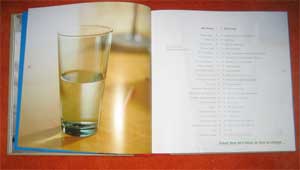However, while the words have changed, it is basically what Donald Clifton writes about in Soar with Your Strengths.
While neither book does much to back up their point with any evidence as they lack any real research, the Parable of the Rabbit, from Clifton's book, is perhaps the most interesting part of the two books and more than likely all you need to read to understand what both authors are driving at.
However, the real point of the post is the way Crammer and Wasiak's book is designed -- pictures fill up the pages just as much as the text, if not more. While I like a good picture to help understand or reinforce the text, it seems that Change the Way You See Everything goes beyond this. While beautiful to look at, it seems, well, quite gimmicky. Many of the photos do nothing to help understand the book.

Change the Way You See Everything
Perhaps the one book that pulled this off successfully was McLuhan's The Medium is the Massage, who uses pictures to create a montage demonstrating the effects of the media.

The Medium is the Massage
This typographic experimentation by authors can be quite good at times, such as Rick Moody's The Diviners. While the book was only so-so, the author blocked out a page of text to depict a page read by a character that has itself been blocked out, leaving only the words "such" and "thirst."

The Diviners
If the visual carries the same narrative weight as the text itself, then it often becomes superfluous, and if it replaces the text, then it almost seems to become a shorthand for language itself. Yet if the author is successful with the visual, then it works in parallel with the text to promote understanding. As a learning designer, how do you know when to use a visual? And when do you know to stop before it comes to the point of being gimmicky?




3 comments:
Don,
Having done a lot of work in the field of multimedia, where the question of balance between text and image is vital (more particularly video, in my case) and then 10 years ago moving into the Web, which is essentially a print-screen medium, this is a subject I've given a lot of thought to.
In general the way things work today is that text is seen as a medium that gives the answers (e.g. of the expert who wrote the book, the article or the e-learning course) and images appear as helpful illustrations of those answers or examples of the problems that led the experts to those answers. The equivalent in a court of law it would be the lawyer's defense argument supported by available bits of material evidence. All meaning conveyed revolves around an interested thesis and a single point of view.
That's how things work when the paradigm is "teaching". We would be justified in expecting that they should change when the paradigm shifts to learning. When used creatively, images can play a different role, as the medium that raises questions inviting further discourse. I believe, as you do, that McLuhan was well aware of that and did what he could in the print medium to show it.
Of course, this isn't the way most people use images, hence the common feeling that pictures confuse the text or are simply there to add weight or color.
What I've spent a lot of time exploring as an author, multimedia publisher and facilitator of learning (working directly with learners) is using images first of all to raise issues of perception and the interpretration of the visual (this also works with sound, of course). This enables two essential actions:
1) learners' digging into their own experience and culture rather than just listening to the conclusions of the expert
2) understanding the flexibility of the relationship between the evidence (concrete reality) and the conclusions we are meant to draw from it.
The end result is learning in which personal stakes other than rewards for performance exist, making further growth and deeper understanding possible. It also stimulates one of the key elements in any authentic learning process: providing a basis for creative discourse with the stamp of one's own personality and viewpoint alongside awareness of the discourse of others (including the authorities who do the "teaching").
This method works best if the learning process contains some form of authentic dialogue with multiple inputs. But even that is possible in books. The most educational novel I've ever read (and reread) is Laurence Sterne's Tristram Shandy, whose occasional images invite us to think about everything that's going on: the story we're reading, the narrator who's telling it, the author who's writing it, the publisher who's producing it, the culture from which it comes, the conventions of writing, printing, reading, the status of fiction, and the value of images in books! Not a bad achievement.
The one thing they don't do is to illustrate some pedantic point the narrator or author is making.
One little afterthought.
It has always seemed to me that the two most important phases in learning are perception and communication. Knowledge can and must be sandwiched somewhere between the two. But in our pedagogic tradition, the two most important of the three have been repressed. How many educational professionals are even aware of the importance of perception and communication? Some lip service is paid to the latter but it's considered secondary to knowledge and rarely explored in any depth.
Can it be that the growing awareness of social learning, where perception and communication are necessarily at the top of the list, will change all that?
It is often true that "a picture's worth a thousand words". I find that sometimes I would recall having seen a picture in a book, which in turn would remind me of the associated passages / contents.
That's a part of the reason why TV commercials, being visual, can be very effective. When people go shopping and are faced with multiple brands of the same product, all of which s/he has not used before, but they are able to connect one of them to a commercial they have seen, chances are they would choose that one (assuming prices are similar).
Post a Comment